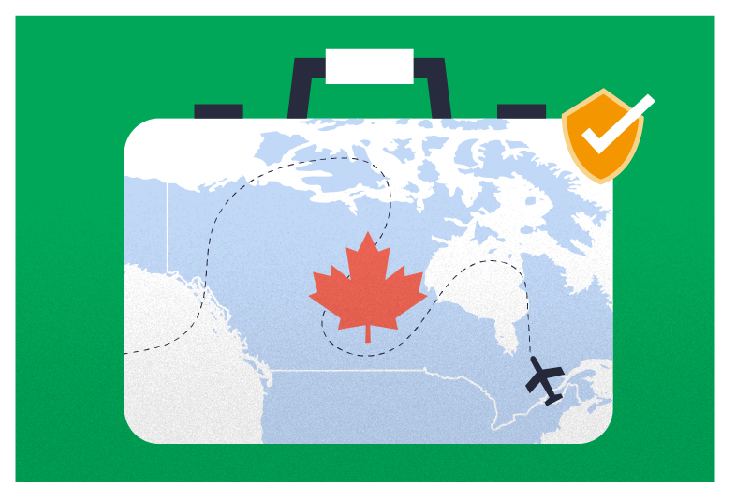When it comes to planning travel, Canadian businesses and individuals often face a pivotal question: should they opt for traditional travel insurance or leverage a Health Spending Account (HSA)?
With the evolution of healthcare benefits and tax policies, understanding the nuances of HSA vs travel insurance in Canada becomes crucial. These plans differ significantly in coverage, tax advantages, and flexibility, which can profoundly influence cost savings and convenience.
This article will explore how HSAs offer notable tax-free coverage for travel-related medical expenses while sidestepping the often costly and restrictive bundled insurance plans.
Introduction

Travel planning for Canadians with incorporated businesses raises complex questions, especially regarding health coverage while abroad. Many resort to traditional travel insurance, which offers broad protection but comes with premiums, restrictions, and bundled policies.
Alternatively, an HSA provides a flexible, tax-efficient way to reimburse eligible medical expenses incurred during trips. Dissecting the HSA vs travel insurance in Canada debate highlights the potential benefits of HSAs—not only for savings but for streamlined claim processes and compliance with CRA regulations.
Understanding these options enables businesses and professionals to choose cost-effective strategies aligned with their needs.
In the core of this comparison lies the differentiation: HSAs are tax-advantaged reimbursements for eligible expenses, whereas travel insurance is a premium-paying safeguard against uncertainties.
Yet, many overlook how HSAs can directly cover travel-related medical costs, offering personalized, tax-efficient solutions unattainable with standard insurance.
HSA and Travel Insurances explanation

Understanding the fundamental differences between an HSA and travel insurance is essential for making informed decisions. Health Spending Accounts, as designated Private Health Services Plans (PHSPs) approved by the CRA, facilitate reimbursements for qualified medical expenses, including some travel-related costs.
These expenses encompass emergency hospital visits, prescriptions, and outpatient treatments, provided they meet the CRA’s guidelines for medical necessity.
By contrast, travel insurance functions as a comprehensive premium-based policy designed to cover unexpected events such as medical emergencies, trip cancellations, lost baggage, and more. Travel insurance packages are typically bundled with other travel perks, which can inflate costs and limit flexibility.
Many providers incorporate these bundled plans, which may include non-essential add-ons, leading to unnecessary expenses. This bundled structure often complicates claims and restricts customization, while HSAs enable tailored reimbursement for specific, CRA-eligible costs.
Key Benefits of HSAs Over Travel Insurance

The decision between HSA vs travel insurance in Canada hinges on several critical advantages that HSAs provide, particularly regarding tax efficiency, flexibility, and cost control.
Tax Efficiency: Maximize Reimbursements
One of the centerpiece benefits of HSAs is their tax treatment. Reimbursements for eligible medical expenses made through an HSA are 100% tax-deductible, and the funds are received tax-free. This contrasts sharply with being subjected to premiums for travel insurance, which are not tax-deductible expenses.
Utilizing an HSA allows incorporated individuals and businesses to significantly reduce net costs and optimize their tax strategy. For professionals like self-employed Canadians, this translates into tangible savings and more efficient expense management.
The tax advantages extend beyond immediate savings. Because HSA reimbursements count as business expenses, they can decrease taxable income overall, further boosting financial health. Plus, since these accounts are designed to be flexible, they permit reimbursement for various eligible costs without cumbersome restrictions, making the process straightforward and compliant with CRA rules.
Various tools and platforms, including solutions from Wellbytes, simplify claims tracking and ensure proper documentation—an essential component for compliance.
Flexibility: Custom Coverage for Travel Needs
Unlike traditional travel insurance packages that bundle coverage with mandatory add-ons, HSAs offer significant flexibility. They are designed to reimburse CRA-eligible medical expenses, which can include emergency hospital visits, outpatient care, prescriptions, and even certain travel-related costs like medical evacuations.
This targeted approach ensures that businesses focus on what matters most during travel without paying for unnecessary coverage or extraneous benefits.
Flexibility also manifests in the ability to capitalize on specific needs. For instance, if a small business wants to cover prescriptions for employees traveling abroad, an HSA can be tailored accordingly.
This contrasts sharply with one-size-fits-all travel insurance plans that often impose rigid coverage parameters. An HSA empowers both corporations and self-employed individuals to create bespoke benefit plans aligned with their unique travel and health needs—an approach increasingly favored in modern tax planning.
Cost Control: Avoid Premium Inflation and Additional Fees
High premiums are a common complaint among travelers purchasing insurance plans. Travel insurance providers often include layered charges for add-ons or optional coverages, which quickly inflate overall costs. Conversely, HSAs are primarily claims-driven, meaning you only pay for actual expenses incurred. This cost-effective method avoids paying upfront for coverage that may never be utilized.
Additionally, HSAs eliminate the “bundled” nature of traditional policies, reducing the risk of paying for unnecessary extras. Businesses leveraging standalone HSAs, supported by platforms like Wellbytes, can significantly lower their health-related travel costs. This approach allows for more precise budget management and ensures funds are used only when necessary, maximizing benefits and avoiding waste.
Examples on travel insurances that can use HSA
Real-world scenarios illustrate how HSAs outperform traditional travel insurance for Canadian professionals and businesses.
For example, an incorporated consultant based in Alberta traveling to the U.S. may face unexpected medical emergencies—such as sudden hospitalizations—that cost thousands.
With an HSA, they can reimburse the $1,000 expense, tax-free, provided it meets CRA criteria, saving substantial money compared to paying out-of-pocket or being constrained by limited insurance coverage.
Similarly, a small Toronto-based business might have employees who need prescriptions or emergency treatments while abroad. Instead of incurring a $1,200 premium for a bundled travel insurance policy covering dental, cancellations, and medical emergencies, the employer can set up an HSA to directly reimburse $2,500 in eligible expenses. This flexible, tax-efficient approach allows the business to optimize employee benefits without excessive premiums.
These examples demonstrate that HSAs are not only cost-effective but also adaptable, providing benefits tailored to specific travel scenarios while ensuring compliance and maximizing tax advantages.
Cost Breakdown Scenarios
To clarify the financial implications of choosing HSAs over traditional travel insurance, consider the following scenario:
Option
- HSA (Standalone): Covers claims up to $3,000 annually, with potential tax savings for the business.
- Travel Insurance (Bundled): Premiums around $1,500 annually.
Annual Cost (Example)
| Plan | Cost | Tax Savings (assuming 35%) | Coverage Scope |
|---|---|---|---|
| HSA (Standalone) | $3,000 in claims | $1,050 | Eligible travel medical expenses, emergency treatments, prescriptions |
| Travel Insurance (Bundled) | $1,500 premium | $0 (non-deductible premiums) | Medical emergencies, cancellations, baggage loss |
This visual comparison underscores the cost advantages of HSAs, not only because of lower premiums but also due to potential tax deductions. The flexibility to claim only what’s necessary further enhances the cost-effectiveness of HSAs.
Step-by-Step Process to Use HSA for Travel Expenses
To maximize benefits from an HSA during travel, follow a straightforward process designed for clarity and compliance.
Step 1: Confirm HSA Eligibility
First, verify that your business qualifies as an incorporated entity following CRA guidelines. This status enables you to establish a self-funded, CRA-eligible Private Health Services Plan (PHSP).
Platforms like Wellbytes simplify this process by providing comprehensive support and compliance checks, ensuring your setup adheres strictly to CRA regulations. Proper eligibility is the foundation for claiming legitimate reimbursements tax-free.
Step 2: Review CRA Guidelines
Next, review the CRA’s criteria for eligible expenses, focusing on travel-related medical costs. These include emergency hospital visits, outpatient treatments, and prescriptions during travel. It’s crucial to consult CRA guidelines or trusted resources to determine your covered expenses. Staying informed helps prevent denied claims and ensures compliance.
Step 3: Choose a Standalone HSA Provider
Select a provider capable of offering an independent, transparent HSA—one that does not bundle coverage with unnecessary add-ons.
Wellbytes offers such solutions, allowing users to manage claims seamlessly via a proprietary CRM platform and mobile app, ensuring quick access and efficient claims submission. Solo or small business users benefit from simplified administration and dedicated support.
Step 4: Submit Claims Digitally
During or after travel, submit eligible expenses through the provider’s digital platform, such as the Wellbytes mobile app. Proper documentation, receipts, and proof of expenses are necessary for smooth reimbursement. Utilization of digital tools accelerates processing, reduces errors, and maintains compliance—a sign of modern, user-centric benefits management.
Step 5: Receive Tax-Free Reimbursements
Once approved, reimbursements are processed swiftly, and funds are transferred tax-free, directly to your account. Continuous compliance checks ensure that claims meet CRA requirements, preserving the tax-advantaged status of the account. This straightforward process underscores the advantages of utilizing a dedicated platform for claims management.
FAQs about travel insurance
Q: Do HSAs cover travel expenses?
A: Yes, with specific limitations. CRA-eligible costs include emergency medical treatments, hospital visits, and prescriptions but do not cover trip cancellations or non-medical expenses. Ensuring expenses meet CRA criteria is essential for tax-free reimbursement.
Q: Is travel insurance mandatory with HSAs?
A: No. In fact, tying insurance policies with HSAs can violate CRA regulations, risking non-compliance. Standalone HSAs are sufficient, providing targeted, compliant coverage for specific medical expenses during travel.
Q: How to ensure CRA compliance?
A: Use providers that conduct claim reviews and verify expenses against CRA guidelines. Maintaining detailed receipts, explanations, and timely claims submission helps avoid issues.
Platforms like Wellbytes facilitate this process through integrated claim management tools, providing transparency and peace of mind.
Transparency tips also include reviewing the “Avoid Hidden HSA Fees in Canada” guidance to prevent unexpected costs.
Future Trends
As digital health benefits management advances, HSAs are poised to become the preferred choice in 2025 and beyond. Their capacity for quick claim processing via mobile apps, along with increasing CRA scrutiny on bundled plans and hidden fees, emphasizes the shift toward transparent, standalone HSAs.
Future developments will likely include enhanced integration with tax and compliance tools, making HSAs even more accessible and attractive for Canadian businesses and individuals alike.
Conclusion
In the evolving landscape of health and travel coverage in Canada, HSAs present a compelling alternative to traditional travel insurance—combining tax advantages, flexibility, and cost control.
They allow incorporated Canadians to tailor medical expense reimbursement specifically for their travel needs, avoiding bundled premiums and unnecessary add-ons. Utilizing trusted providers like Wellbytes simplifies the claims process, ensures CRA compliance, and maximizes savings.
As digital tools and CRA policies continue to favor standalone HSAs, this approach is well-positioned to become the standard for cost-effective, flexible travel medical coverage in Canada. Exploring such options today can yield significant long-term benefits—so consider booking a consultation with a health benefits advisor to optimize your benefits strategy.
